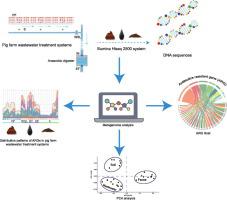Science of the Total Environment ( IF 8.2 ) Pub Date : 2020-11-21 , DOI: 10.1016/j.scitotenv.2020.143654 Rong-Min Zhang , Xiao Liu , Shao-Lin Wang , Liang-Xing Fang , Jian Sun , Ya-Hong Liu , Xiao-Ping Liao

|
Vast reservoirs of antibiotic resistance genes (ARG) are discharged into the environment via pig manure. We used metagenomic analysis to follow the distribution and shifts of ARGs and their bacterial hosts along wastewater treatment in three large pig farms. The predominating ARGs potentially encoded resistance to tetracycline (28.13%), aminoglycosides (23.64%), macrolide-lincosamide-streptogramin (MLS) (12.17%), sulfonamides (11.53%), multidrug (8.74%) and chloramphenicol (6.18%). The total relative ARG abundance increased along the treatment pathway prior to anaerobic digestion that had a similar degradative capacity for different ARGs and these ARGs were reduced by about 25% after digestion, but ARGs enriched erratically in manured soils. Distinctive ARG distribution patterns were found according to the three sample locations; feces, soil and wastewater and the differences were primarily due to the tetracycline ARGs (feces > wastewater > soil), sulfonamide ARGs (soil > wastewater > feces) and MLS ARGs (feces > wastewater > soil). Metagenomic assembly-based host analyses indicated the Proteobacteria, Firmicutes, Actinobacteria and Bacteroidetes were primary ARG carriers. The Streptococcaceae increased the abundance of multidrug, MLS and aminoglycoside ARGs in feces; Moraxellaceae were the primary contributors to the high abundance of multidrug ARGs in wastewater; the Comamonadaceae led to the higher abundance of bacA in wastewater and soil than feces. We found a high level of heterogeneity for both ARGs and ARG-hosts in the wastewater treatment system and in the agricultural soils for these pig farms.
中文翻译:

猪场废水处理系统和猪粪施肥土壤中抗生素抗性基因及其细菌宿主的分布规律
大量的抗生素抗性基因(ARG)通过以下途径排入环境猪粪。我们使用宏基因组学分析追踪了三个大型养猪场中ARGs及其细菌宿主随废水处理的分布和变化。主要的ARGs可能编码对四环素(28.13%),氨基糖苷(23.64%),大环内酯-林可酰胺-链霉菌素(MLS)(12.17%),磺酰胺(11.53%),多药(8.74%)和氯霉素(6.18%)的抗性。厌氧消化前沿处理途径的总相对ARG丰度增加,对不同的ARG具有相似的降解能力,消化后这些ARG降低约25%,但ARG在肥育土壤中富集。根据三个样本位置发现了明显的ARG分布模式。粪便,土壤和废水,差异主要归因于四环素ARG(粪便> 废水>土壤),磺酰胺ARGs(土壤>废水>粪便)和MLS ARGs(粪便>废水>土壤)。基于元基因组组装的宿主分析表明,变形杆菌,硬毛菌,放线菌和拟杆菌是主要的ARG携带者。的链球菌可增加粪便中多种药物,MLS和氨基糖苷ARG的含量。莫拉菌科是废水中多种药物ARGs含量高的主要原因。在Comamonadaceae导致了大量的高BAC废水中的A和土壤比粪便。我们发现在废水处理系统和这些养猪场的农业土壤中,ARG和ARG宿主均存在高度异质性。











































 京公网安备 11010802027423号
京公网安备 11010802027423号